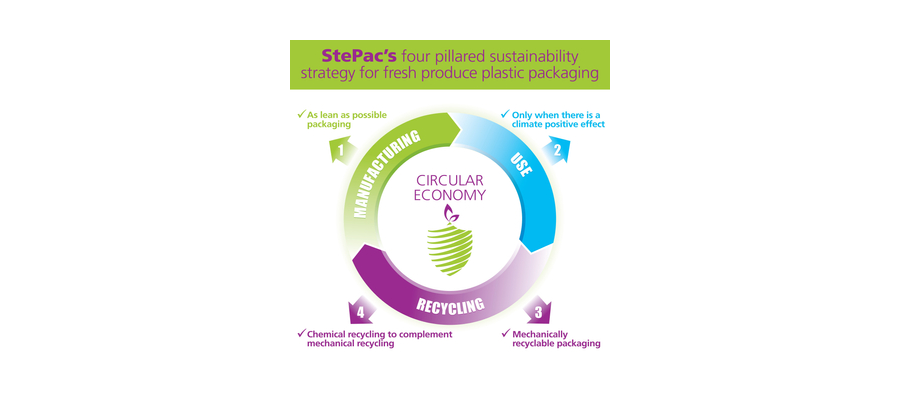StePac reveals its innovative four-pillared strategy for greener packaging.
Tefen, Israel – Fresh produce packaging experts at StePac L.A., Ltd., present the company’s four pillared sustainability strategy for fresh produce packaging. The advanced strategy effectively mitigates the necessity of climate-positive plastic packaging, addressing the critical problem of food waste. StePac will present its progressive stratagem at a sustainability event it is hosting at the PMA Fresh Summit in Anaheim on Saturday, 19th October, 2019.
Food waste is a global epidemic, with almost a third of all food and nearly half of all fresh produce wasted annually. Not only does this create an ethical crisis, with millions suffering food depravation around the world, but it creates an environmental crisis — food waste contributes to about 8% of global greenhouse gas emissions.
The conundrum: As fresh food requires travel and processing from field-to-fork, abandoning plastic packaging would inevitably exacerbate the crisis, as plastic is the medium most capable of keeping food fresher, longer and allows for wider food distribution.
StePac has designed a four-tiered strategy that can reduce excessive plastic use while driving more responsible packaging, leading the sector from a linear economy toward a circular one through applying a more responsible, leaner, and sustainable approach. The new strategy addresses key areas of manufacturing, use, and recycling.
“Plastic packaging plays a critical role in the fresh produce and food industry, not least because of its ability to dramatically curtail food waste,” says Gary Ward, Ph.D., Business Development Manager for StePac. “Our technology is based on four pillars of sustainability designed to significantly lighten the environmental footprint of plastic packaging.
1st pillar: Use plastic packaging only if it has positive climate effect.
StePac’s leading brand of Xtend® modified-atmosphere packaging is “Climate Positive,” extending shelf life and reducing waste in the fresh produce supply chain while saving more carbon emissions than it generates.
The company was a pioneer in developing packaging solutions that, in one example, enabled Peruvian exporters to make the transition from air freight to sea freight of white asparagus to Europe. This resulted in an incredible reduction of 5,500 kg CO2 emissions/ton of product shipped.
In another example, Xtend packaging also proved a compelling replacement for waxed cartons in the shipment of broccoli from Salinas Valley, California across the American continent to New York City. The result: a net saving of 144 kg/ton of broccoli — a 40% reduction. “Rejecting the use of such innovative packaging for similar supply chains would increase carbon emissions and drag the industry a big, unsustainable — and expensive — step backwards,” insists Ward.
2nd Pillar: Climate-positive packaging must be as lean as possible.
Use of StePac’s lean top-seal film reaps the dual benefits of extending shelf-life while saving 20-30% plastic over conventional clamshells.
“We use films that are typically 20-35 microns thick for both preformed bags and automated packaging — considerably thinner than most alternatives,” explains Ward.
StePac’s patented Xflow™ packaging system was developed to facilitate a shift to automation for packaging bulk produce, reducing plastic use by as much as 40% in comparison to manual packing in pre-formed bags.
3rd Pillar: Mechanically recyclable packaging should support a circular economy.
Mechanical recycling recovers plastics waste via processes encompassing grinding, washing, separating, drying, re-granulating and compounding and keeps polymers intact. Although many structures can be mechanically recycled, only pure streams of plastic types such as PET bottles and polyethylene permit multiple -use in the same or similar products. The non-pure plastics can only be mechanically recycled for down-streamed products and as such don’t support a circular economy.
StePac boasts a range of homopolymer-based products with modified atmosphere properties, that can be mechanically recycled to support a resource-efficient looped system. These include polyethylene-based bulk packaging products, polyethylene-based standing pouches and PET-based top-seal solutions, all suitable for those produce items and supply chains that benefit from films having a low water-vapor transmission rates.
4th Pillar: Chemical recycling should complement mechanical recycling
More sophisticated, multilayered laminated structures have emerged over the years in the fresh produce packaging industry that cannot be mechanically recycled to be reused in the same or similar products. Chemical recycling converts plastic materials into their initial monomers, allowing them to be reborn into new plastic products.
“Replacing these sophisticated plastic structures without increasing waste is no simple task,” adds Ward. “We have multilayered plastic structures that conform to chemical recycling, a process which is complementary to mechanical recycling systems in facilitating a true circular economy. This is the direction the industry is taking, and StePac’s goal is to lead it toward a more sustainably sound phase.”
# # #
About StePac
StePac specializes in functional packaging for fresh produce. Its globally recognized brands include Xtend®, Xgo™, Xflow™ and Xbloom™ modified-atmosphere/modified-humidity packaging solutions. These solutions reduce weight loss, slow respiration and aging, and inhibit microbial decay, while prolonging storability and shelf life. They are supported by a wealth of post-harvest expertise for enhanced performance and sustainability. The company is a wholly owned subsidiary of Johnson Matthey, plc, UK.
Company Contact:
StePac, Johnson Matthey
Ms. Hila Nagel
Marketing Communications
Tel: +972.4.612.3500
info@StePac.com
www.StePac.com
@StePac_Xtend
Press Contact
NutriPR
Ms. Liat Simha
liat@nutripr.com
www.nutripr.com
Twitter: @LiatSimha
